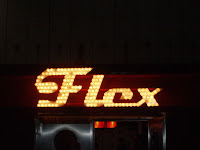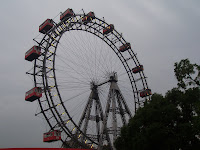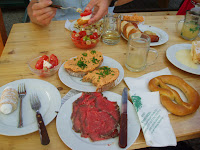Today featured a return to my favorite museum in Vienna, the Leopold. We held our final class meeting today as well, discussing modern day Austria. I have never studied it in any classes, nor have I read much about it in newspapers, so it was fascinating to me to learn so much about the current situation of the place I’ve been staying for the past month. We discussed the two major parties, ÖVP and SPÖ, as well as the formation of the state following WWII. Overall, it was a very interesting lecture to end the class. The professor also shared some stories of her mother and grandmother following WWII in
Berlin, which were absolutely amazing and brought a real life component to the study of history.
After our final class, I returned to the Leopold with a few others who wanted to see the museum again. We first got a delicious English breakfast at the museum café and then proceeded to enjoy the wonderful offerings of the museum, including Kolo Moser, Gustav Klimt, and Egon Schiele. I had plenty of time to investigate the Moser exhibit this time, and it was extraordinary. The man was so talented, making furniture, drawings, posters, decorating buildings and churches, creating stamps and money, and of course, painting. He definitely is the face of the Secession and much of the Jugendstil style, since he decorated the Secession building, dominated the inside  design of it for exhibitions, and created their symbol. After he left the Secession with Klimt (1905) and was co-founder of the Wiener Werkstätte (Vienna Workshop, which he left in 1907), he still created stunning and impressive art until his death in 1918 (the same year that took Klimt and Schiele as well). I really enjoyed viewing his furniture and the jewelry he designed, as well as his paintings – particularly “The Light”, and his vision of people (who he made with blue brush strokes). Unfortunately, I won’t be able to visit the church that he and Otto Wagner created – it is only open on Saturdays for one hour. Well, I guess I just have to come back to Vienna sometime.
design of it for exhibitions, and created their symbol. After he left the Secession with Klimt (1905) and was co-founder of the Wiener Werkstätte (Vienna Workshop, which he left in 1907), he still created stunning and impressive art until his death in 1918 (the same year that took Klimt and Schiele as well). I really enjoyed viewing his furniture and the jewelry he designed, as well as his paintings – particularly “The Light”, and his vision of people (who he made with blue brush strokes). Unfortunately, I won’t be able to visit the church that he and Otto Wagner created – it is only open on Saturdays for one hour. Well, I guess I just have to come back to Vienna sometime.
The fin-de-siècle artists interest me so much more now because I know the historical context of their work, from the Ringstraβe era to the end of the Habsburg dynasty. Their work is an exploration outside the strict confines of the time, going into the new and exciting – whether it is the colors and gold of Klimt or the obsession with decay and death of Schiele. They wanted to throw out the falsity they felt the Ringstraβe embodied (all the ‘neo’ buildings, with no new styles). Prior to this trip, I had never even heard of Kolo or Egon, thanks to Vienna I am now aware (and obsessed) with their amazing bodies of work.
Egon, in particular, fascinates me with his short life, chilling paintings, and sad biography. Dr. O  did a fantastic job introducing us to his art when we first visited the museum, so it was great to go back and experience it again! I particularly enjoyed the work called “Transfiguration” this time around. I still cannot get over the way he paints hands. He is definitely an artist I cannot wait to learn more about, so I bought a book on him before I left the amazing museum. I am so jealous of Rudolf Leopold!
did a fantastic job introducing us to his art when we first visited the museum, so it was great to go back and experience it again! I particularly enjoyed the work called “Transfiguration” this time around. I still cannot get over the way he paints hands. He is definitely an artist I cannot wait to learn more about, so I bought a book on him before I left the amazing museum. I am so jealous of Rudolf Leopold!
I then concluded my Vienna museum going with a visit to the Jüdisches Museum. The top floor features its viewable storage section. It is not in any particular order and is truly just a storage and cataloguing section, as opposed to a museum exhibit. It was the most stunning part of the museum to me, which otherwise did not leave a particular impact. But that room alone did enough. The storage area did the best at conjuring the vision of a once flourishing community that now seems to be simply behind glass. Seeing the items that were burned in the pogroms, as well as the items taken when the Nazis closed down the original museum and used some of the items to create an anti-Semitic display in the Naturhistorisches museum, saddened me. To know how deeply people wanted to destroy a culture and its people – and seeing the physical residue of that hatred – is a horrible and terrifying feeling.
items taken when the Nazis closed down the original museum and used some of the items to create an anti-Semitic display in the Naturhistorisches museum, saddened me. To know how deeply people wanted to destroy a culture and its people – and seeing the physical residue of that hatred – is a horrible and terrifying feeling.
I did not get such a deep feeling in the rest of the museum. The use of holograms – the purpose of them being so that you cannot touch it and truly be a part of it, but it looks lifelike – felt cloying and unimpressive. I realize that is their idea of memorializing the history – to make it so that the view changes with the location and to impart the feeling that one can never really be in the past – but it did not interest me.
After the museum visit, I did some shopping and headed out for dinner. We tried to go to a place the guidebook recommended, called Una, which has an amazing ceiling and is in the very  awesome MuseumsQuartier, but it was completely packed. Instead, we headed out to the always reliable (even in the pouring rain!) Rathaus for delicious Indian food, some sturm (oh, how I will miss that drink), and “Kiss Me Kate.” Then we headed for a night out at my favorite club ever – Flex in Vienna. It was the awesome “London Calling” night and it completed my Vienna nightlife experience. I got to dance on the stage, see the “Legend of Flex” (a forty-five year old man who goes weekly and dances crazily), and just have an amazing, only in Vienna experience. I cannot begin to say how great today was – I’m not ready to leave Vienna!
awesome MuseumsQuartier, but it was completely packed. Instead, we headed out to the always reliable (even in the pouring rain!) Rathaus for delicious Indian food, some sturm (oh, how I will miss that drink), and “Kiss Me Kate.” Then we headed for a night out at my favorite club ever – Flex in Vienna. It was the awesome “London Calling” night and it completed my Vienna nightlife experience. I got to dance on the stage, see the “Legend of Flex” (a forty-five year old man who goes weekly and dances crazily), and just have an amazing, only in Vienna experience. I cannot begin to say how great today was – I’m not ready to leave Vienna!
 lunch! After that came the search for Adolf Loos’s public toilets, which I’d wanted to find for awhile. Yes, I realize they are simply a bathroom, but it’s Loos, who also did my favorite café,
lunch! After that came the search for Adolf Loos’s public toilets, which I’d wanted to find for awhile. Yes, I realize they are simply a bathroom, but it’s Loos, who also did my favorite café,  famous Ferris Wheel in the Prater, followed by a dinner of
famous Ferris Wheel in the Prater, followed by a dinner of  four swords at Centimeter. The ferris wheel (Riesenrad) is a major symbol of
four swords at Centimeter. The ferris wheel (Riesenrad) is a major symbol of 
 hilarious, fun, and delicious food that was presented to us on swords! I had my final radler and enjoyed hanging out with the group. After the dinner, a large group of us went to go hang out at the Communist Café, but we were thwarted once again – it was full! We then went to a local microbrewery and enjoyed the night out.
hilarious, fun, and delicious food that was presented to us on swords! I had my final radler and enjoyed hanging out with the group. After the dinner, a large group of us went to go hang out at the Communist Café, but we were thwarted once again – it was full! We then went to a local microbrewery and enjoyed the night out.  continue learning about other cultures and their history has grown enormously. The language barrier here in Vienna – although not so bad since most people speak perfect English – has inspired me to try to obtain more of a fluency in another language, as I’m sadly limited to
continue learning about other cultures and their history has grown enormously. The language barrier here in Vienna – although not so bad since most people speak perfect English – has inspired me to try to obtain more of a fluency in another language, as I’m sadly limited to English and a bit of reading knowledge of French. More than anything, I want to return to
English and a bit of reading knowledge of French. More than anything, I want to return to 





























